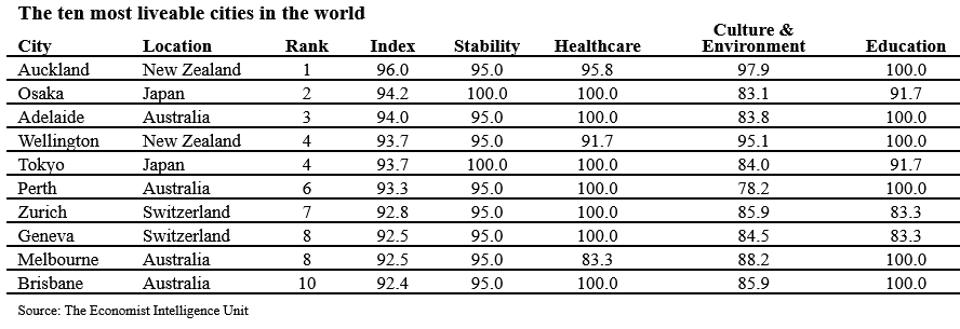By Kenneth Rapoza : Forbes : 08-06-2021
Who wants to live in a city today?
Between protests in the U.S. and London last year, and a pandemic where living in apartment buildings and touching things a hundred people just touched, and riding in their crowded trains, sounds less appealing today than it has in years.
“The COVID-19 pandemic has taken a heavy toll on global livability,” says Upasana Dutt, Head of Global Livability at The Economist Intelligence Unit. They released their annual Livability Index on Tuesday after market hours.
“Cities across the world are now much less livable than they were before the pandemic began,” she says.
The good news is that most American cities have risen in the rankings as a result of a reduced strain on the healthcare system and removal of lockdown restrictions that’s made life more enjoyable than those still unable to dine in a restaurant or go to sporting events.
The livability study assesses 30 indicators which include aspects of public safety and education among other things. The data compares the movements within these categories over a period of six months, so the gains, or declines, are over a short period.
In their previous survey for instance, many global cities were faced with serious healthcare crises on account of the global pandemic, pushing their numbers lower last summer.

Auckland is the most livable city, rising to the top spot thanks to its successful approach in containing the Covid-19 pandemic. The city also scores strongly on a number of metrics including education, culture and environment.
In the U.S., Honolulu was the biggest gainer. It rose 46 places to 14th place after its strong progress in containing the spread of the virus in Hawaii’s capital. The city witnessed a rise in its healthcare score of 33 points compared with the previous survey as hospitals there managed without any major capacity problems.
In Latin America, Caracas is now one of the worst cities in the world. Led by the Socialists United party, aka PSUV, the party led by Hugo Chavez’s old colleague Nicholas Maduro has become a basket case city with lackluster medical supplies and even transportation infrastructure, like the basics of delivering oil and gas to gasoline stations, has made it unlivable.
Santiago, Chile was one of the worst performing cities in the region as well, thanks to lockdown restrictions and the overall impacts of the healthcare crisis there.
Data for the survey was collected between February and March, just as Auckland was actually going into lockdown again.
Also, while stability scores have not improved in many American cities, including New York, they haven’t declined either. So their overall scoring for the category remains stable.
“Livability in U.S. cities has improved compared to European and Canadian cities,” says Dutt. Over that February to March period, Ontario was doing their best imitation of Wuhan, and parts of Germany were also locking down again.
Theaters and restaurants were closed in some cities, adding to lower livability scores.
“We have seen U.S. cities in general performing better in the rankings as a result of better management of healthcare resources as compared to the previous survey where the healthcare scores had declined due to significant strains,” she says.


Recent Comments